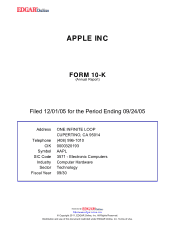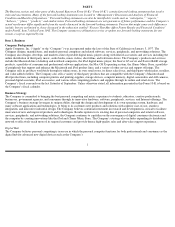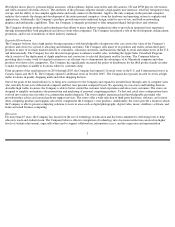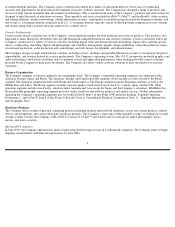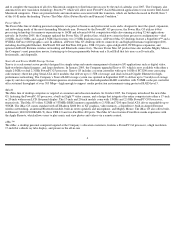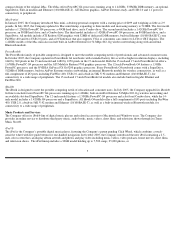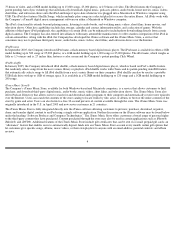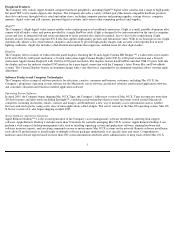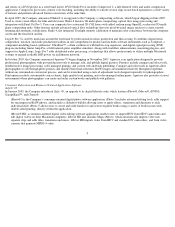Apple 2005 Annual Report Download - page 6
Download and view the complete annual report
Please find page 6 of the 2005 Apple annual report below. You can navigate through the pages in the report by either clicking on the pages listed below, or by using the keyword search tool below to find specific information within the annual report.
and to complete the transition of all of its Macintosh computers to Intel microprocessors by the end of calendar year 2007. The Company also
announced its new translation technology, Rosetta™, which will allow most PowerPC-based Macintosh applications to run on new Intel-based
Macintosh computers. There are potential risks and uncertainties associated with this transition, which are further discussed in Part II, Item 7
of this 10-K under the heading “Factors That May Affect Future Results and Financial Condition.”
Power Mac
®
The Power Mac line of desktop personal computers is targeted at business and professional users and is designed to meet the speed, expansion,
and networking needs of the most demanding Macintosh user. Powered by the PowerPC G5 processor, the Power Mac G5 utilizes 64-bit
processing technology for memory expansion up to 16GB and advanced 64-bit computation while also running existing 32-bit applications
natively. In October 2005, the Company updated the Power Mac G5 product line, which now comes in three processor configurations—dual
2.0GHz, dual 2.3GHz, and a quad 2.5GHz that features two 2.5GHz dual processors. All Power Mac G5 desktops feature a SuperDrive™
and a
NVIDIA GeForce 6600 graphics card. In addition, all Power Mac G5 desktops deliver connectivity and high
-performance input/output (I/O),
including dual Gigabit Ethernet, FireWire® 800 and FireWire 400 ports, USB 2.0 ports, optical digital I/O, PCI Express expansion, and
optional AirPort®
Extreme wireless networking and Bluetooth connectivity. The new Power Mac G5 product line also includes Mighty Mouse,
the Company’s next generation mouse, featuring up to four programmable buttons and a Scroll Ball that lets users scroll vertically,
horizontally, and diagonally.
Xserve
® and Xserve RAID Storage System
Xserve is a rack-mount server product designed for simple setup and remote management of intensive I/O applications such as digital video,
high-resolution digital imagery, and large databases. In January 2005, the Company upgraded Xserve G5, which is now available with either a
single 2.0GHz or dual 2.3GHz PowerPC G5 processor. Xserve G5 includes a system controller with up to 16GB of PC3200 error correcting
code memory; three hot-plug Serial ATA drive modules that deliver up to 1.5TB of storage; and dual on-board Gigabit Ethernet for high-
performance networking. The Company’s Xserve RAID storage system was updated in September 2005 to deliver up to 7 terabytes of storage
capacity and also expanded support for heterogeneous environments. The dual independent RAID controllers with 512MB cache per controller
offer sustained throughput of over 385 Mbps—high enough to support media production environments using protected RAID level 5.
iMac®
The iMac line of desktop computers is targeted at consumer and education markets. In October 2005, the Company introduced the new iMac
G5, featuring the PowerPC G5 processor, a built-in iSight™ video camera, and a design that integrates the entire computer into either a 17-
inch
or 20-inch widescreen LCD flat-panel display. The 17-inch and 20-inch models come with 1.9GHz and 2.1GHz PowerPC G5 Processors,
respectively. The iMac G5 offers 512MB of 533MHz DDR2 memory expandable to 2.5GB and 7200 rpm Serial ATA drives expandable up to
500GB. The iMac G5 comes standard with ATI Radeon X600 Pro or XT graphics, video memory, a SuperDrive, built-in Airport Extreme
wireless networking, an internal Bluetooth module, built-in stereo speakers and microphone, and Mighty Mouse. The iMac G5 also offers built-
in Ethernet (10/100/1000BASE-T), three USB 2.0 and two FireWire 400 ports. The iMac G5 also features Front Row media experience with
the Apple Remote, which allows users to play music and view photos and videos via a remote control.
eMac™
The eMac, a desktop personal computer targeted at the Company’s education customers, features a PowerPC G4 processor, a high resolution
17-inch flat cathode ray tube display, and preserves the all-in-one
4

